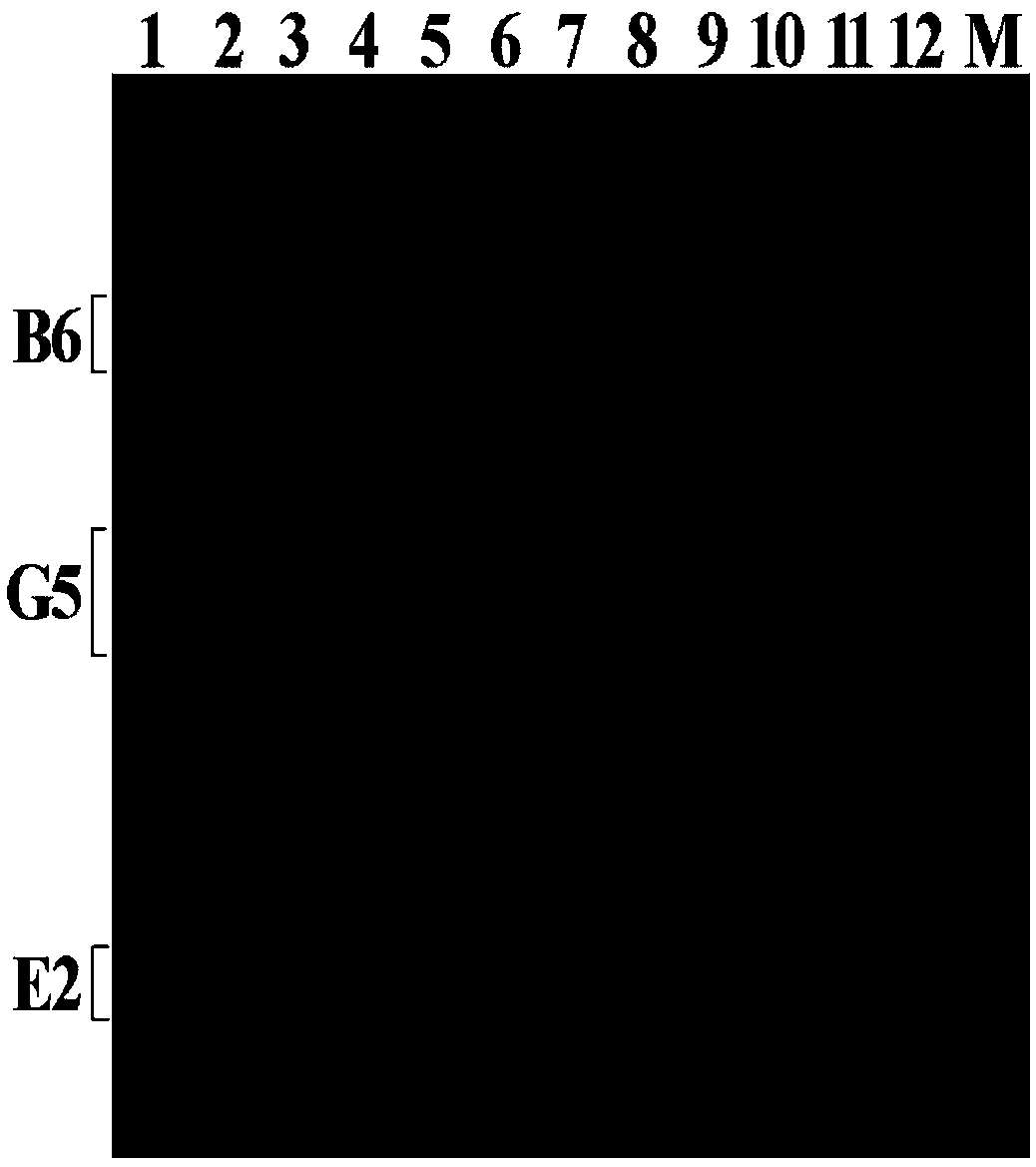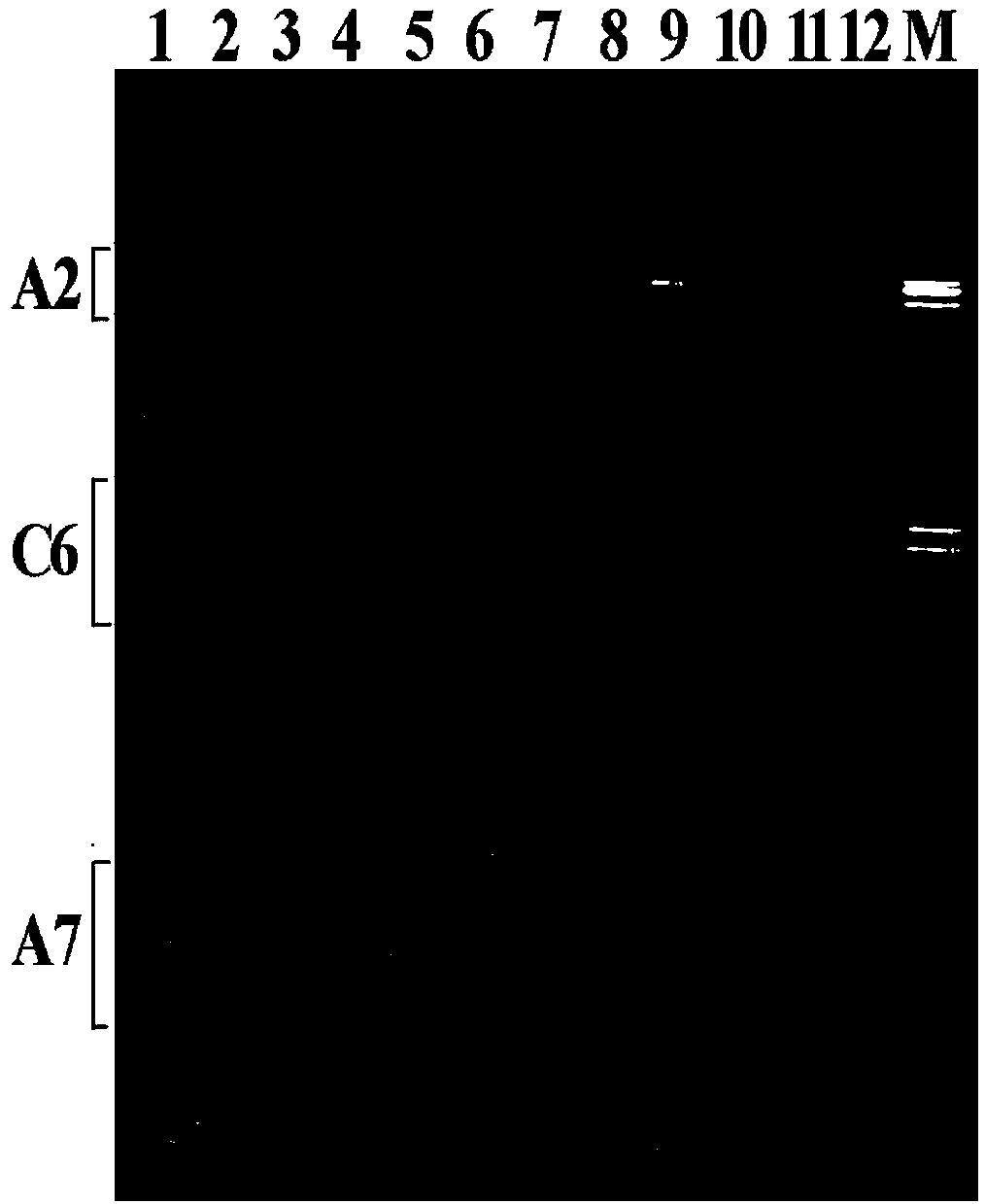Method for SSR (simple sequence repeat) analysis of tetraploid alfalfa by multiplex PCR (polymerase chain reaction) fluorescence labeling technique
A fluorescent labeling and alfalfa technology, which is applied in biochemical equipment and methods, and microbial measurement/inspection, can solve the problems of low efficiency and high cost, and achieve the effect of high efficiency, low cost and easy identification
- Summary
- Abstract
- Description
- Claims
- Application Information
AI Technical Summary
Problems solved by technology
Method used
Image
Examples
Embodiment 1
[0048] 1. Genomic DNA extraction and primer synthesis
[0049] Using the alfalfa cultivar Supersonic as the test material, 12 individual plants were randomly selected, and enough young leaves were cut out, frozen and ground in liquid nitrogen, and the genomic DNA was extracted by the CTAB method of Doyle et al. The quality and quantity of genomic DNA were detected by electrophoresis on % agarose gel.
[0050] Synthesize group A primers BBI131, GBG230 and E776153 according to the primer sequences in Table 1, add the M13(-21) universal primer sequence to the 5' end of the primer leading strand, and then covalently bind the fluorescent label Cy5 before M13(-21) .
[0051] 2. Multiplex PCR
[0052] (1) The reaction system comprises the following components:
[0053] Template DNA 1.5ng / μL, Taq DNA polymerase 0.035U / μL, dNTPs 0.25mM, 1×PCR Buffer (containing 1.5mM MgCl 2 ), the forward and reverse primer concentrations of primers BBI131F, GBG230 and E776153 are shown in Table 2,...
Embodiment 2
[0061] 1. Genomic DNA extraction and primer synthesis
[0062] Using alfalfa variety Zhonglu No. 1 as the test material, 12 individual plants were randomly selected, and enough young leaves were cut off, frozen and ground in liquid nitrogen, and the genomic DNA was extracted by the CTAB method of Doyle et al., with λDNA as the reference standard. The quality and quantity of genomic DNA were detected by electrophoresis using 0.8% agarose gel.
[0063] Synthesize group B primers DMt1H10, CBF156 and DBI28 according to the primer sequences in Table 1, add M13(-21) universal primer sequence to the 5' end of the primer leading strand, and then covalently bind fluorescent marker 6 before M13(-21) ' - FAM.
[0064] 2. Multiplex PCR
[0065] (1) The reaction system comprises the following components:
[0066] Template DNA 1.5ng / μL, Taq DNA polymerase 0.030U / μL, dNTPs 0.25mM, 1×PCR Buffer (containing 1.5mM MgCl 2 ), the forward and reverse primer concentrations of primers DMt1H10, C...
Embodiment 3
[0074] 1. Genomic DNA extraction and primer synthesis
[0075] Using the alfalfa variety Juneng as the test material, 12 individual plants were randomly selected, a sufficient amount of young leaves were cut, and after freezing and grinding with liquid nitrogen, genomic DNA was extracted by the CTAB method of Doyle et al. The quality and quantity of genomic DNA were detected by electrophoresis on % agarose gel.
[0076] Synthesize group C primers ABE93, CIC338 and AMTIC95 according to the primer sequences in Table 1, add the M13(-21) universal primer sequence to the 5' end of the primer leading strand, and then covalently bind the fluorescent label Cy5 before M13(-21) .
[0077] 2. Multiplex PCR
[0078] (1) The reaction system comprises the following components:
[0079] Template DNA 1.50ng / μL, Taq DNA polymerase 0.030U / μL, dNTPs 0.25mM, 1×PCR Buffer (containing 1.5mM MgCl 2), the forward and reverse primer concentrations of primers ABE93, CIC338 and AMTIC95 are shown in ...
PUM
 Login to View More
Login to View More Abstract
Description
Claims
Application Information
 Login to View More
Login to View More - R&D
- Intellectual Property
- Life Sciences
- Materials
- Tech Scout
- Unparalleled Data Quality
- Higher Quality Content
- 60% Fewer Hallucinations
Browse by: Latest US Patents, China's latest patents, Technical Efficacy Thesaurus, Application Domain, Technology Topic, Popular Technical Reports.
© 2025 PatSnap. All rights reserved.Legal|Privacy policy|Modern Slavery Act Transparency Statement|Sitemap|About US| Contact US: help@patsnap.com



